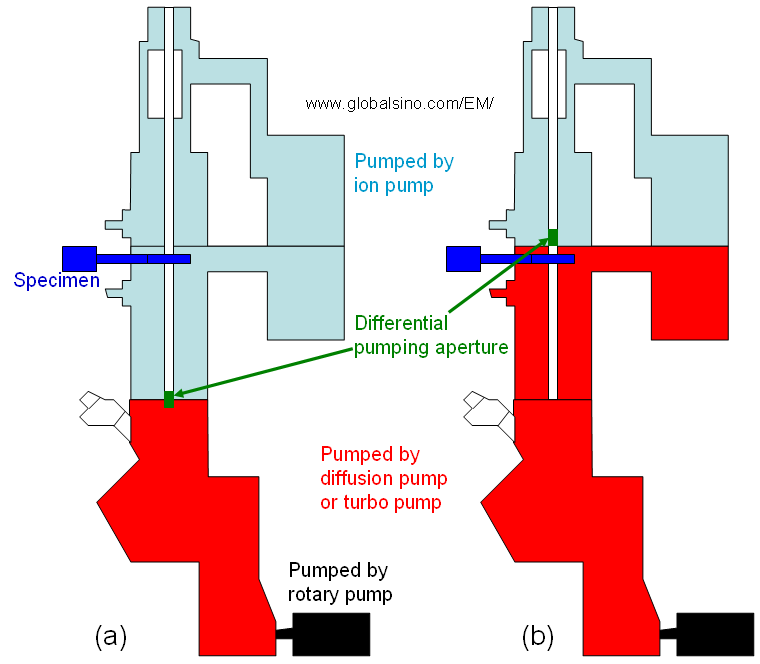=================================================================================
In EM systems, the electron source and top end of the microscope is often pumped by an ion pump. This part of the microscope is almost entirely separated from the sample region and viewing chamber by a differential pumping aperture in a width of few tens of microns. This aperture "hole" is large enough to let the confined electrons beam pass down the column, but it is small enough to maintain a differential pressure. In this way, it is possible to have a “poor” vacuum in the sample region and viewing chamber (e.g. 10-4 mbar) but an ultrahigh vacuum (e.g. 10-8 mbar or better) in the source region. Therefore, by applying differential pumping the ultra-high vacuum parts of the microscope is separated in a dynamic way from the high vacuum parts by the aperture in a proper size.
As shown in Figure 3588 (a), in most modern TEMs, the electron gun, top lenses, and specimen chamber are maintained at ultra-high vacuum by an ion pump, while the viewing screens and photographic chamber are maintained at a lower vacuum, which is referred to as high vacuum, by either a diffusion pump or a turbomolecular pump. This vacuum level is backed by a mechanical (rotary) pump. However, some TEMs have lower vacuum in the specimen chamber as shown in Figure 3588 (b).

Figure 3588. Vacuum in TEMs: (a) Modern TEMs, and (b) Some TEMs.
For the in-situ TEM experiments based on gas-solid or gas-liquid interactions, the gas or liquid needs to be confined to the sample area in order to protect the column vacuum of TEM. The modified part, used to confine the gas or liquid, is known as environmental cell (E-cell), which can be achieved mainly by two methods:
i) Vacuum sealed electron transparent windows above and below the sample are used. This method can be obtained by specially designed TEM/STEM holder.
ii) A combination of small apertures and extra pumps are used in the TEM column. This system is also known as differential pumping system. [1-4]
For this type of in-situ TEMs, gas leakage from the specimen into the microscope column occurs so that the microscope vacuum is controlled by the size of apertures. The microscope vacuum is controlled by the dynamic balance between:
i) The gas flow into the cell.
ii) The leak rate through the cell aperture.
iii) The differential pumping aperture.
iv) The pumping speed of the microscope
[1] P. Butler and K. Hale, In Situ Gas-Solid Reactions, Practical Methods in Electron
Microscopy, Experimental Microscopy (North Holland Co., 1981), pp. 239 and 309.
[2] R. Sharma and P. A. Crozier, Transmission Electron Microscopy for nanotechnology
N. Y. Z. L. Wang (ed.) (Springer-Verlag and Tsinghua University Press, 2005),
pp. 531–565.
[3] L. Marton, Nature 133, 911 (1935).
[4] T. L. L. Daulton, B. J. Lowe, and J. Jones-Meehan, Microscopy and Microanalysis 7,
470 (2001).
|